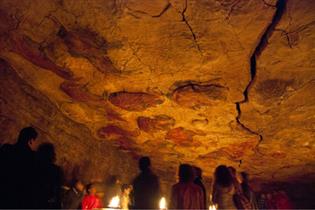Ministry of Culture and Sport publishes technical document on guidelines for conservation of cultural heritage and visits following health crisis
News - 2020.6.1
The Ministry of Culture and Sport published a technical document on Monday entitled "Guidelines for the management, conservation and public enjoyment of cultural heritage in the de-escalation from the health crisis". This guide, drawn up by the Institute for Cultural Heritage of Spain (Spanish acronym: IPCE), with the approval of the Ministry of Health, offers detailed recommendations for the correct conservation of cultural assets and on their use under optimal conditions of health and safety.
The text, distributed to the regional governments and cultural institutions, seeks to serve as a reference manual that caters for both different cultural manifestations that make up Spain's cultural heritage, and for their different ownership, uses, types of management, size, senior staff, etc. This joins the collection of specialised technical documents that the Directorate-General of Fine Arts published during the health crisis in relation to archives, museums and historical heritage.
As well as general recommendations, the guide sets out other specifications that affect the protection of moveable and immoveable goods, celebrations and visits to places of worship, monuments, archaeological sites, caves and pot-holes, museums, archives and libraries, and intangible cultural heritage manifestations.
Safety distance and limits on use of reduced spaces
The guide recommends, among other measures, keeping doors open that are not automatic to avoid contact with door handles; the deactivation of tactile elements; taking great care over air renewal; avoiding fumigation and cloths with disinfectant solutions; changing the use of stately furniture for general use, such as chairs, tables and benches, with other furniture with no stately value that can be washed; and the placing of disinfectant mats in access areas.
A ban on accessing those areas with a limited space or that are accessed through narrow two-way passages, galleries or narrow staircases, such as in towers, bell-towers, decks, clerestories, crypts, etc. is advisable. These areas should never be included in the calculation to establish the maximum capacity of visitors to the installations.
The text also calls for management to avoid routes over historical elements located on floors, such as tombs, tiles with inscriptions, etc., on which disinfectant solutions should never be applied.
Specific guidelines for religious activities
Among the specific measures on religious spaces, the use of historical religious collection plate is unadvisable and it is recommended that they be replaced by modern religious objects that can be washed with mild soap. This recommendation extends to cloth items (altar hangings, coverings and cloths), which should be replaced by more modern items.
Special care should also be taken with the rites and customs that cannot be guaranteed under safe conditions, do not offer self-protection and where it is hard to maintain social distancing, including those that require direct contact with the surfaces of cultural assets (kissing of feet of statues, hugging images, etc.) that could become a source of contagion. "The use in these cases of damp cloths with disinfectant solutions is not an option, since this gravely endangers the conservation of the cultural assets", clarifies the text.
Archaeological sites with one-way routes
 Pool MoncloaAs regards visits to archaeological sites, it is advisable to establish a route for visitors that is clearly marked by signs and one-way, and to control bottlenecks on walkways, limiting visiting times at viewpoints and strategic points on the route that require stopping to appreciate the location.
Pool MoncloaAs regards visits to archaeological sites, it is advisable to establish a route for visitors that is clearly marked by signs and one-way, and to control bottlenecks on walkways, limiting visiting times at viewpoints and strategic points on the route that require stopping to appreciate the location.
Spaces to stop with a limited capacity or that do not meet the safety requirements should be removed from the visit and visits by groups that have not previously been organised to common, non-museum, areas are not recommended.
In the case of pot-holes and caves, disposable footwear should be made available at sites for all visitors, and a container for their disposal at the exit. Due to the specific location of this type of cultural assets, only preventive actions should be taken, avoiding disinfecting and fumigating. "The very nature of these spaces, as well as their natural ultraviolet radiation, will have limited any virus load over the lockdown", states the text.
As regards archaeological digs, the guide recommends that excavation areas be divided into quadrants of at least two square metres, with an individual or a team assigned to each quadrant. In the case of digs in reduced spaces, such as caves and pot-holes, work should be performed on an individual basis, with only one person per quadrant during the whole chain of work (excavation, cleaning, sifting and washing).
Without date changes for intangible cultural heritage manifestations
The text stresses the effect of COVID-19 on intangible cultural heritage and recalls the recent cancellation of a large number of intangible cultural manifestations, such as Easter Week celebrations and Las Fallas in Valencia, as well as a host of festive celebrations of local patron saints.
The guide considers, following the provisions established in the National Plan to Safeguard Intangible Cultural Heritage, that official dates are a key element in the organisation of intangible cultural manifestations, and advises dates not to be changed. "The processes and techniques for most manifestations, celebration rituals, remembrance services, etc. are governed by timelines that tend to be tied into the annual calendar of a cyclical structure, and directly and inalienably related to this season or the specific date of their celebration", states the text.
Non official translation




